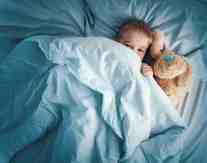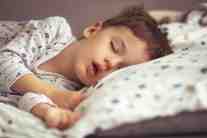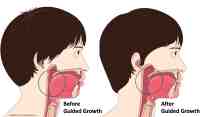
Symptoms of Sleep Disordered Breathing In Children
- Aggressive Behavior
- Dark Circles Under Eyes
- Nightmares
- Swollen Adenoids or Tonsils
- Crooked or Crowded Teeth
- Delayed or Stunted Growth
- Mouth Breathing
- Bedwetting
- Learning Problems
- ADD / ADHD
- Snoring
- Lower IQ
- Speech Difficulties
- Leg or Arm Flailing
The overwhelming odds are that a child you know suffers from one of these unhealthy medical or social conditions. In fact, more and more kids in America are experiencing one or more of these problems every day. It seems that the last few decades have generated an onslaught of problems for America’s kids. These conditions seem to be totally random with nothing in common. However, research over the past 20 years has linked each of these conditions to a common cause.
Children’s Sleep Disordered Breathing (SDB) is a physical disorder that disrupts a child’s sleep pattern. Sleep Disordered Breathing can cause a reduction in the amount of oxygen that a child's body and brain receives during sleep. They don't get the kind of restorative sleep that a growing child needs and they end up being chronically tired.
In addition to these childhood problems, Children's Sleep Disordered Breathing has also been linked to adult problems like:
- Migraines
- Heart Disease
- Chronic Respiratory Disease
- Cracked and Broken Teeth
- TMJ Disorder

Type 1 Sleep Disordered Breathing
Kids play hard and get exercise when they do. However, Type-1 SDB results from the tongue and lower jaw not getting enough of a workout in the first five years of the child's development. To illustrate this problem, think about a boy who has broken his leg. A cast is put on the leg to keep the muscles and bone as still as possible. However, the old saying, "Use it or lose it" comes into play here. From the very first day of casting, the leg muscles and bone begin to shrink and get weaker. That is why the doctor gets the leg into a walking cast as quickly as possible. The pressure of walking reminds the leg that it still has work to do and to stop atrophying.
The same thing can happen to a child’s developing lower jaw. Many parents wean their child onto soft and pureed baby foods. However, mushy baby foods don't require the child to chew. The tongue doesn’t have to move things around to position food for the teeth to chew and the jaw and teeth have nothing to bite, dice and grind. That tricks the child's developing lower jaw and tongue into thinking they are not needed just like the leg cast tricks the leg muscles and bone into thinking there is nothing to do. The jaw and tongue don’t grow and may, in fact, shrink while the rest of the head continues to grow normally.
The face takes on a distinctive receding chin look because the lower jaw and the tongue don’t keep up with the growth of the rest of the face. The lower jaw and tongue are being pushed back into the throat and constricting the airway. In this case, the chin is not receding but rather, stunted. A child may be able to breathe well enough when upright, however, lay the child on his or her back to sleep and you’ve got a problem. The muscles of the throat relax and shut down the airway even more. Just like adults with Obstructive Sleep Apnea, children may stop breathing for 10 - 30 seconds at a time or even longer as they sleep.
Type 2 Sleep Disordered Breathing
Children with obstructed nasal airways usually sleep with their mouths open as they try to compensate for the diminished air flow through their noses. Many people ask, “So the child breathes through the nose and another child breathes through the mouth. What’s the difference? What’s the big deal?”
What exactly is Children's Sleep Disordered Breathing? There are two kinds of Sleep Disordered Breathing. One type involves the airway in the child's throat and the other involves the nasal airways.
It turns out that noses are not just holes in our head. Noses actually do some incredible things for the human body. They filter the incoming air stopping germs, allergens, dust particles and mold spores. They also warm the incoming air so the temperature is corrected before it ever hits our lungs. And, finally, they moisten the air to keep our lungs working at peak efficiency.
When we breathe through our mouths, it’s like having a funnel dumping air straight into our lungs. Junk isn’t filtered out of the air, so we are more susceptible to airborne illnesses, developing allergies and suffering from chronic pulmonary problems. The air isn’t pre-warmed, so the lungs must do the work of warming the air up to body temperature. And, finally, the incoming air is dry, so the lungs must create the humidity to maintain the mucous membrane that allows oxygen to get into our blood.
But that’s not the worst part about children becoming mouth breathers. You see, as soon as your newborn began nursing, the tongue began doing it's most important work. Within days of birth, the tongue begins to shape the structure of your child’s mouth and face and protect the nasal airways. You may ask, “What do you mean, ‘protect’ the nasal airways?” The cheeks and lips are powerful muscles and they are constantly contracting and squeezing. That continual pressure squeezes the upper jaw together and pushes the roof of the mouth upward. If the tongue is living in the roof of the mouth, it counteracts this damaging force by pushing outward every time you swallow. And, since we swallow from 1300 to 1600 times a day, a delicate balance is maintained. However, if the child is a mouth breather, the tongue isn’t up in the roof of the mouth doing that job.

How does a child become a mouth breather?
Sometimes it’s a birth defect that causes the problem. The child may have been born with a tongue tie where the frenulum, that little flap of skin under the tongue, is holding the tongue down. In the case of a tongue tie, the tongue is physically prevented from protecting the nasal airways. Luckily, this is easily treated with a quick procedure at the dentist's office.
The second way the child becomes a mouth breather is by having a stunted chin. When a child has a stunted chin, it can be almost impossible for them to completely close their mouth when they are not consciously doing so.
The most common way that a child becomes a mouth breather is when they find themselves on the “Illness Carousel.” There is nothing about this never-ending ride that is any fun for the child or the parents. The ride begins when a child develops cold after cold or one sinus infection after the other. This causes them to breathe through their mouths while sleeping. As we found out earlier, that allows the cheeks and lips to squeeze the upper jaw and push the upper palate up and into the nasal airways. With each successive illness, their upper palate gets pushed up into their nasal airways. Eventually the child’s nasal airways have been squeezed down so much that they are now forced to breathe through their mouth whether they are sick or healthy. At this point, the child has “forgotten” how to breathe through their nose and will mouth breathe all the time. In fact, even if they consciously try to keep their mouth closed for ten breaths in succession, they will be forced to open their mouth to breathe before they get to the 10th nasal breath.
Finally, there is one more way for children to become mouth breathers. Babies and toddlers have been under attack by bottle nipples, pacifiers and their own thumbs for decades. As a child sucks on a bottle nipple, the tongue presses it into the roof of the mouth. The roof of the mouth is then pushed up into the nasal airways, making them smaller and smaller. As they get smaller, they transport less oxygen. To get more oxygen, the child needs to breathe through the mouth. And, if that's not bad enough, the act of sucking draws the cheeks and lips inward which squeezes the upper jaw, further pushing the roof of the mouth upward into the nasal airways. As the nasal airways shrink further, the child begins to mouth breathe both night and day in order to keep the flow of oxygen going.
Many people ask, “Wait! Isn’t breastfeeding sucking as well?” Actually, it’s not. Milk comes out of the breast when the child’s tongue squeezes the soft nipple against the roof of the mouth. As the mother’s nipple flattens out the milk is pressed out, not sucked out. The tongue presses up and outward continually expanding the palate.
Now that you’ve learned what becoming a mouth breather can do to a child’s upper palate and the nasal airways, you may be wondering if there are other side effects of the condition. When the cheeks and lips squeeze the upper jaw together, they not only raise the roof of the mouth, they also squeeze the gums together. This can lead to one of the cruelest sources of bullying and teasing in the elementary grade school environment.
When the upper gums are squeezed in, they no longer match up with the gums in the lower jaw. Because baby teeth are usually smaller and more widely spaced than adult teeth, everything is okay for a while. However, when the adult teeth start to come in, there isn’t enough room at the party for everyone and teeth become crowded. If you were unlucky enough to suffer from this condition when you were young, you know how cruel classmates can be. Most dentists or orthodontists simply pulled these “extra” teeth and then used braces to pull the rest of the teeth together to fill in the resulting spaces. Of course, now we know that doing so often leads to painful TMJ Dysfunction as an adult.

When treated early enough, the damaging effects of Children’s Sleep-Related Disordered Breathing can usually be undone. In fact, in most cases, it may be totally reversed. Whether a child suffers from Type-1 SDB (where the growth of the lower jaw and tongue has been delayed) or Type-2 SDB (where the upper jaw has been deformed), we can use oral appliances, nutrition, oral exercises and palatal expanders to allow facial and oral structures to either "catch-up" to normal or “return” to normal.
We serve families throughout the Greater Richmond, Virginia area, including Chesterfield, Henrico, Powhatan, and Hanover counties as well as the cities of Richmond, Hopewell, Colonial Heights, and Petersburg. Download our free BEARS questionnaire below to find out if your child might be suffering from sleep disordered breathing. If so, request an appointment today!

